
The Davis–Adcock Store is a historic general store located at Wilbon, North Carolina, a crossroads north of Fuquay-Varina, in Wake County, North Carolina. The building was constructed in 1906, and is a one-story, frame, gable-front building, with a standing-seam metal roof and a stepped-parapet false front. The community store served not only as a local distribution center for goods and services, but also as a center of community social life. The building also housed the local post office from 1906 until 1925.

The Oliver House is a historic house at 203 West Front Street in Corning, Arkansas. It is a 2 1⁄2-story wood-frame L-shaped structure, with a gambrel-roofed main block and a gable-roofed section projecting forward from the right side. A single-story hip-roofed porch extends through the crook of the L and around to the sides, supported by Tuscan columns. The interior retains original woodwork, including two particularly distinguished fireplace mantels. Built c. 1880 and last significantly altered in 1909, it is one of Corning's oldest buildings. It was built by J. W. Harb, and purchased not long afterward by Dr. J. L. Oliver Jr., whose son operated a general store nearby.

The Frauenthal House is a historic house at 631 Western Street in Conway, Arkansas. It was designed by Charles L. Thompson and built in 1913, exhibiting a combination of Colonial Revival, Georgian Revival, and Craftsman styling. It is a two-story brick building, topped by a gabled tile roof with exposed rafter ends in the eaves. A Classical portico shelters the entrance, with four Tuscan columns supporting an entablature and full pedimented and dentillated gable. The 5,000-square-foot (460 m2) house, with 22 rooms, was built for Jo and Ida Baridon Frauenthal and is currently occupied by the Conway Regional Health Foundation.

Chamberlin Iron Front Building is a historic commercial building located at Lewisburg, Union County, Pennsylvania. It was built in 1868, and is a three-story, brick building with a two-story rear addition in the Italianate style. It measures 56 feet wide and 160 feet deep. The main section has a flat roof and the addition a gable roof. It features a cast-iron front manufactured in Danville, Pennsylvania. Over the years the building has housed a general store, shoe store, feed store, and post office, as well as fraternal organizations on the upper floors.

The Oark School—Methodist Church is a historic church at the junction of Arkansas Highway 215 and County Road 34 in Oark, Arkansas. It is a rectangular single-story wood frame structure, with a gabled roof, novelty siding, and a fieldstone foundation. The gable ends of the roof are adorned with large knee brackets. Originally built c. 1923 as a collaboration between the local Methodist congregation and the school district, it served as both a public school and Methodist academy, the latter for a single season. It was used as a public school until 1938, when the district was consolidated with other area districts. It was briefly used as a school again in the 1950s, after the existing school burned down. It is now used as a community meeting hall.
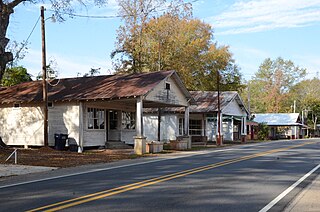
The New Edinburg Commercial Historic District encompasses the historic commercial center of New Edinburg, Arkansas. It includes ten contributing buildings lining Arkansas Highway 8, just north of its junction with Farm Market and Banks Roads. At the time of its listing on the National Register of Historic Places in 2001, all of these buildings, built between c. 1898 and 1940, stood vacant, reflecting the decline of the area.
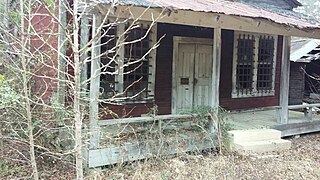
The Holt–Poindexter Store Building is a historic retail building in rural Ouachita County, Arkansas. It is located on County Road 101, near its southern junction with County Road 111, about 4 miles (6.4 km) north of Stephens, in the unincorporated community of Ogemaw. The store, a vernacular single-story wood frame structure with a gable roof and full-width front porch, was built in 1904 by H. B. Holt, and is believed to be the oldest general store in southern Arkansas. A small addition was added to the north side in the 1920s to house post office facilities. This was removed in 1948, at which time a rear addition was added to provide space for an office and feed storage. The business was taken over by Holt's son-in-law, Chester Poindexter, and then his son, Kenneth.
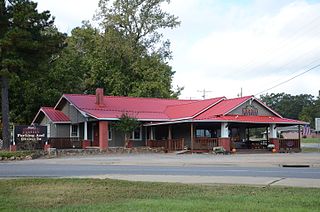
The C. E. Thompson General Store and House is a historic property at 3100 Hollywood Road in Arkadelphia, Arkansas. Its principal structure is a single-story wood-frame with a gable roof, which was built in 1936 and served as a residence for the Thompson family and as a general store until it closed in the 1980s. It is the only Craftsman-style general store building in Arkadelphia. The building currently houses Allen's Barbeque, a local barbeque restaurant. The property includes other historically significant buildings, including a garage, wellhouse, privy, shed, smokehouse, and barn.

The Wittsburg Store and Gas Station is a historic retail establishment on Cross County Road 637 in Wittsburg, Arkansas. It is the only commercial building in the community. Built c. 1930, it is a single-story wood frame structure with a gable roof and a false front. A shed-roof porch extends across the front, supported by for square posts. The main entrance is centered, flanked by sash windows. A gable-roofed section extends from the rear of the building, providing residential space for the shop, which occupies the main block. The building also features a concrete storm cellar, and there is a period gas pump to the building's southeast. The store operated from the 1930s to the 1980s, and is a reminder of Wittsburg's former status as a significant river town.
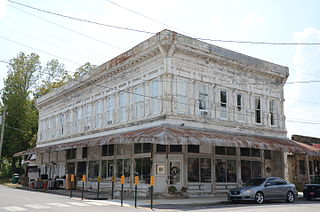
J.C. Berry's Dry Goods Store is a historic commercial building at 331 Old South Main Street in Yellville, Arkansas. It is a two-story block, built out of local limestone with pressed metal trim. The ground floor has a glass commercial store front, sheltered by a porch, and the second story has a bank of six windows, each flanked by a pair of Ionic pilasters. The roof has an extended overhang supported by brackets, and a highly decorated parapet. The metal elements of the facade were manufactured by the Mesker Brothers, a nationally known producer of metal architectural goods based in St. Louis, Missouri. The building was built in 1903 by J.C. Berry, and was operated as a dry goods business until 1912, when Berry's nephew Rex Floyd converted it for use as a hotel after his Park Hotel burned down. The hotel closed in 1952, and the building has seen a succession of mixed commercial and residential uses.

The Stamps Store is a historic commercial building on Arkansas Highway 103 in Osage, Arkansas, a hamlet off United States Route 412 between Alpena and Huntsville. It is a 2-1/2 story stone structure, with a front-gable roof, and vernacular Romanesque Revival styling. The first floor was originally a large open retail space used as a general store, the second floor was a residential space for the proprietor, and the upper half-story was a meeting space. It was built 1899-1902 by Willie and Millie Sneed, and was operated by the Stamps family from 1912 to 1990. It was listed on the National Register of Historic Places in 1990 for its architecture and its historical importance to the small community.

The Col. Jacob Yoes Building is a historic commercial building on Front Street in Chester, Arkansas. It is a two-story brick structure, with styling typical to its 1887 construction date. It has segmented-arch windows, a band of corbelled brickwork at the cornice, below the flat sloping roof. The building was designed to house a dry goods store in one storefront, and a hotel lobby in the other, with guest rooms on the second floor. It is the only commercial building in the center of Chester to survive a pair of devastating fires in the early 20th century.

The Revel General Store is a historic commercial building at the southwest corner of Arkansas Highway 260 and Woodruff County Road 17 in Revel, Arkansas. It is a small single-story vernacular wood-frame structure, finished in its original weatherboard siding, and sporting a false parapet in front of a gabled roof. Built in 1908, it is the only commercial building in the hamlet, served as its general store until about 1975.

The George D.D. Huie Grocery Store Building is a historic commercial building at 1400 North Pine Street in North Little Rock, Arkansas. It has a single-story front section with a gable roof, which housed the retail space, with a two-story rear section used as the proprietor's residence. This buff brick building was built by George Huie, a Chinese immigrant, in 1949 on the site of a store he had operated since 1938. The store is historically important for its role in the growth and development of the local Chinese community, and for its service to the historically African-American neighborhood in which it stands. It presently houses a small museum.

Hankins' Store is a historic commercial building at Ferry Road and Main Street in Oil Trough, Arkansas. It is a single-story wood frame structure, built out of local cypress lumber, with a gable roof and clapboard siding that is original to its 1904 construction. An open porch extends across its front. The store stands near the White River Slough, a former course of the White River. It served the local community for almost exactly 100 years, closing in 2004, and typifies early 20th-century general stores.

The Wheel Store is a historic commercial building at River and Broad Streets in Batesville, Arkansas. It is a two-story ashlar sandstone structure, with a flat roof. Its front facade has a single storefront, with two now-filled window openings flanking the entrance on the first level, and two windows above. The building was erected in 1887 to house a store and meeting space for a local chapter of the Agricultural Wheel, an agrarian reform organization established in Arkansas in the early 1880s.

The C.L. Smith & Son General Store is a historic commercial building on Arkansas Highway 66, opposite the courthouse square, in central Mountain View, Arkansas. It is a single-story stone structure, with vernacular Romanesque styling consisting of round-arch window openings flanking a similar entry opening. The front facade is topped by a parapet, which obscures the flat roof, and is stepped down the east side. The store was built in 1905, and is one of the early stone buildings that typify the city center's architecture.

The Thomas Jefferson Hale General Merchandise Store is a historic commercial building in rural south-central White County, Arkansas. It is located south of Searcy, at the southwest corner of the junction of County Roads 62 and 433, known locally as Vinity Corner. It is a single-story wood frame structure, finished with sheet metal siding, instead of brick that was more typically used for commercial construction. Its front faces east, with three fixed windows flanking a double-door entry, and a shed-roof porch extending across its width. It was built about 1925, when the area was more prosperous than it is now, and is its only surviving commercial remnant.
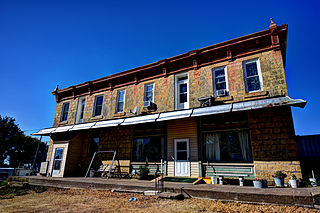
The Kegler-Gonner Store and Post Office, also known simply as Gonner's Store, is a historic commercial building located in Springbrook, Iowa, United States. Christian Kegler had the western portion of this building constructed for his general store about 1874. The post office had relocated here two years previous with Kegler as the postmaster. Three additions were built on to the original structure. The building was in its final form by 1933. John Gonner acquired a part interest in the store in 1904, and operated it outright by 1908. It was still known as Gonner's Store at least into the mid-1980s. The space is now occupied by a restaurant. The second floor houses apartments. At one time the east half of the second floor had been a boarding house.






















